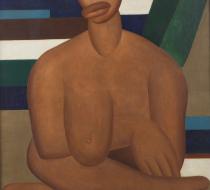Brazil’s Most Famous Art Movement Built on Racial Inequality Favorite
The Shifting View on Anthropofagia
Tarsila is closely associated with the establishment of the Brazilian art movement known as cultural “cannibalism,” or “Anthropofagia”: the then-radical idea that a truly Brazilian art would emerge by ingesting all the different cultures that intermingled within the country, rather than simply copying European styles.
But most scholarship on the movement to date has avoided its complex relationship to race. In a conversation with this reporter, the MoMA exhibition’s co-curator, the Venezuelan-born Luis Pérez-Oramas, said: “Racial tensions exist in Brazil, but the way the culture deals with it, the way the society deals with it is totally different than the way the Americans deal with it. That’s why I am very careful to not racialize a reading of Tarsila because that would be unfair. That would be a colonial take on Tarsila do Amaral.”
Some contemporary Brazilian scholars and artists, however, disagree with Pérez-Oramas.
“One way to actualize the idea of Anthropofagia would be to reflect on the widely accepted understanding of it as it is associated with Brazilian national identity and the myth of Brazilian racial democracy,” says artist Tiago Gualberto. “The lack of criticism of Tarsila do Amaral’s A Negra painting from Afro-Brazilian artists is symptomatic of ways in which black Brazilians are viewed as a theme, or an object, without a voice.”
A Changing Cultural Landscape
Historically, Afro-Brazilians have been neglected by both museums and galleries. Few institutions dedicated to these artists exist in the country. In 2004, artist and curator Emanoel Araújo founded the Museu Afro Brasil. Since then, the institution has become an important center for research on and presentation of works by black artists in Brazil.
Recently, more projects related to the work of Afro-Brazilian artists have begun to emerge. The nonprofit organization Social Service of Commerce (SESC), which operates public galleries throughout the country, has hosted exhibitions such as “Afro Como Ascendência, Arte como procedência” (“Afro as Ancestry, Art as Origin”), curated by Alexandre Bispo in 2013, and “PretAtitude: Insurgências, Emergências e Afirmações na Arte Contemporânea Afro-Brasileira” (“BlackAtitute: Insurgencies, Emergencies and Affirmations in Afro-Brazilian Contemporary Art”), curated by Claudinei Roberto da Silva and on view through May.
Yet Brazil didn’t select an Afro-Brazilian artist to represent the country at the Venice Biennial until 2015, when Paulo Nazareth received the invitation. This is particularly notable considering that, according to the most recent census in 2010, Brazil was home to the most people of African descent outside of Africa. And to date, the São Paulo Museum of Art (MASP), widely considered to be the most important museum in Brazil, has not hosted a solo exhibition by any Afro-Brazilian female artist. That will change in November of this year when the museum presents an exhibition of the work of Sonia Gomes.
Both Nazareth and Gomes are represented by Mendes Wood DM, which has galleries in São Paulo, Brussels, and New York, and stands out as having the most diverse roster of any contemporary Brazilian gallery.
The evolution within the art world reflects larger developments in Brazilian culture that have taken place since the early 2000s, spurred by the progressive policies of former Brazilian president Luiz Inácio Lula da Silva, who held office from 2003 until 2010. Known as Lula, the former factory worker was the first Brazilian president to implement policies that explicitly address racial inequality, including the establishment of affirmative action within higher education and compulsory classes on the history of Africa.
photo: Tarsila do Amaral’s A Negra (1923). Museo de Arte Contemporânea de Universidade de São Paulo. © Tarsila do Amaral Licenciamentos.







